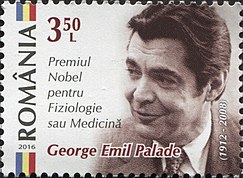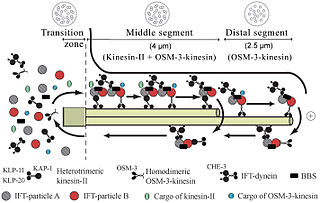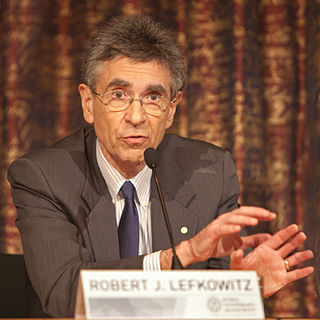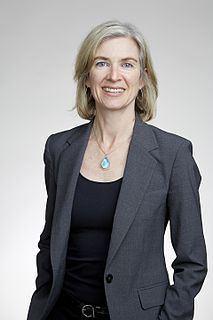Related Research Articles

The cilium is an organelle found on eukaryotic cells in the shape of a slender protuberance that projects from the much larger cell body.

George Emil Palade ForMemRS HonFRMS was a Romanian-American cell biologist. Described as "the most influential cell biologist ever", in 1974 he was awarded the Nobel Prize in Physiology and Medicine along with Albert Claude and Christian de Duve. The prize was granted for his innovations in electron microscopy and cell fractionation which together laid the foundations of modern molecular cell biology, the most notable discovery being the ribosomes of the endoplasmic reticulum – which he first described in 1955.

The State University of New York College of Environmental Science and Forestry (ESF) is a specialized, doctoral-degree granting institution in Syracuse, New York. It is part of the State University of New York (SUNY) system. ESF is immediately adjacent to Syracuse University, within which it was founded, and with which it maintains a special relationship. It is classified among "R2: Doctoral Universities – High research activity".

Howard Martin Temin was a US geneticist and virologist. He discovered reverse transcriptase in the 1970s at the University of Wisconsin–Madison, for which he shared the 1975 Nobel Prize in Physiology or Medicine with Renato Dulbecco and David Baltimore.
Professor Dale Sanders, FRS is a director of the John Innes Centre, an internationally leading institute for research in plant sciences and microbiology in Norwich, England.
James Edward Rothman is an American biochemist. He is the Fergus F. Wallace Professor of Biomedical Sciences at Yale University, the Chairman of the Department of Cell Biology at Yale School of Medicine, and the Director of the Nanobiology Institute at the Yale West Campus. Rothman also concurrently serves as adjunct professor of physiology and cellular biophysics at Columbia University and a research professor at the UCL Queen Square Institute of Neurology, University College London. Rothman was awarded the 2013 Nobel Prize in Physiology or Medicine, for his work on vesicle trafficking. He received many other honors including the King Faisal International Prize in 1996, the Louisa Gross Horwitz Prize from Columbia University and the Albert Lasker Award for Basic Medical Research both in 2002.
Tak Wah Mak, is a Canadian medical researcher, geneticist, oncologist, and biochemist. He first became widely known for his discovery of the T-cell receptor in 1983 and pioneering work in the genetics of immunology. In 1995, Mak published a landmark paper on the discovery of the function of the immune checkpoint protein CTLA-4, thus opening the path for immunotherapy/checkpoint inhibitors as a means of cancer treatment. Mak is also the founder of Agios Pharmaceuticals, whose lead compound, IDHIFA®, was approved by the FDA for acute myeloid leukemia in August 2017, becoming the first drug specifically targeting cancer metabolism to be used for cancer treatment. He has worked in a variety of areas including biochemistry, immunology, and cancer genetics.

Intraflagellar transport or IFT is a bidirectional motility along axonemal microtubules that is essential for the formation (ciliogenesis) and maintenance of most eukaryotic cilia and flagella. It is thought to be required to build all cilia that assemble within a membrane projection from the cell surface. Plasmodium falciparum cilia and the sperm flagella of Drosophila are examples of cilia that assemble in the cytoplasm and do not require IFT. The process of IFT involves movement of large protein complexes called IFT particles or trains from the cell body to the ciliary tip and followed by their return to the cell body. The outward or anterograde movement is powered by kinesin-2 while the inward or retrograde movement is powered by cytoplasmic dynein 2/1b. The IFT particles are composed of about 20 proteins organized in two subcomplexes called complex A and B.
Robert Allan Weinberg is a biologist, Daniel K. Ludwig Professor for Cancer Research at Massachusetts Institute of Technology (MIT), director of the Ludwig Center of the MIT, and American Cancer Society Research Professor. His research is in the area of oncogenes and the genetic basis of human cancer.

Lubert Stryer is the Mrs. George A. Winzer Professor of Cell Biology, Emeritus, at the Stanford University School of Medicine. His research over more than four decades has been centered on the interplay of light and life. In 2007 he received the National Medal of Science from President Bush at a ceremony at the White House for elucidating the biochemical basis of signal amplification in vision, pioneering the development of high density microarrays for genetic analysis, and authoring the standard undergraduate biochemistry textbook, Biochemistry. It is now in its eighth edition and also edited by Jeremy Berg, John L. Tymoczko and Gregory J. Gatto, Jr.

Joan Elaine Argetsinger Steitz is Sterling Professor of Molecular Biophysics and Biochemistry at Yale University and Investigator at the Howard Hughes Medical Institute. She is known for her discoveries involving RNA, including ground-breaking insights into how ribosomes interact with messenger RNA by complementary base pairing and that introns are spliced by small nuclear ribonucleic proteins (snRNPs), which occur in eukaryotes. In September, 2018, Steitz won the Lasker-Koshland Award for Special Achievement in Medical Science. The Lasker award is often referred to as the 'American Nobel' because 87 of the former recipients have gone on to win Nobel prizes.
Marilyn Gist Farquhar was a pathologist and cellular biologist, Professor of Cellular and Molecular Medicine and Pathology, as well as the chair of the Department of Cellular and Molecular Medicine at the University of California, San Diego School of Medicine, who previously worked at Yale University from 1973 to 1990. She has won the E. B. Wilson Medal and the FASEB Excellence in Science Award. She was married to Nobel Laureate George Emil Palade from 1970 to his death in 2008. Her research focuses on control of intracellular membrane traffic and the molecular pathogenesis of auto immune kidney diseases. She has yielded a number of discoveries in basic biomedical research including: mechanisms of kidney disease, organization of functions that attach cells to one another, and mechanisms of secretions.

Robert Joseph Lefkowitz is an American physician and biochemist. He is best known for his groundbreaking discoveries that reveal the inner workings of an important family G protein-coupled receptors, for which he was awarded the 2012 Nobel Prize for Chemistry with Brian Kobilka. He is currently an Investigator with the Howard Hughes Medical Institute as well as a James B. Duke Professor of Medicine and Professor of Biochemistry and Chemistry at Duke University.
Arthur L. Horwich is an American biologist and Sterling Professor of Genetics and Pediatrics at the Yale School of Medicine. Horwich has also been a Howard Hughes Medical Institute investigator since 1990. His research into protein folding uncovered the action of chaperonins, protein complexes that assist the folding of other proteins. Horwich first published this work in 1989.
Pietro De Camilli is an Italian-American biologist and John Klingenstein Professor of Neuroscience and Cell Biology at Yale University School of Medicine. He is also an Investigator at Howard Hughes Medical Institute. De Camilli completed his M.D. degree from the University of Milan in Italy in 1972. He then went to the United States and did his postdoctoral studies at Yale University with Paul Greengard.

Brian Kent Kobilka is an American physiologist and a recipient of the 2012 Nobel Prize in Chemistry with Robert Lefkowitz for discoveries that reveal the workings of G protein-coupled receptors. He is currently a professor in the department of Molecular and Cellular Physiology at Stanford University School of Medicine. He is also a co-founder of ConfometRx, a biotechnology company focusing on G protein-coupled receptors. He was named a member of the National Academy of Sciences in 2011.
The Graduate School of Arts and Sciences (GSAS) at Brandeis University in Waltham, Massachusetts, United States was established in 1953 on a 235-acre suburban campus, located 9 miles outside of Boston, and is one of four graduate schools on campus.
Joseph Schlessinger is a Yugoslav-born Israeli-American biochemist and biophysician. He is chair of the Pharmacology Department at Yale University School of Medicine in New Haven, Connecticut, as well as the founding director of the school's new Cancer Biology Institute. His area of research is signaling through tyrosine phosphorylation, which is important in many areas of cellular regulation, especially growth control and cancer. Schlessinger's work has led to an understanding of the mechanism of transmembrane signaling by receptor tyrosine kinases and how the resulting signals control cell growth and differentiation.
Laura Lee Kiessling is an American chemist and the Novartis Professor of Chemistry at the Massachusetts Institute of Technology. Kiessling's research focuses on elucidating and exploiting interactions on the cell surface, especially those mediated by proteins binding to carbohydrates. Multivalent protein-carbohydrate interactions play roles in cell-cell recognition and signal transduction. Understanding and manipulating these interactions provides tools to study biological processes and design therapeutic treatments. Kiessling's interdisciplinary research combines organic synthesis, polymer chemistry, structural biology, and molecular and cell biology.

Jennifer Anne Doudna is an American biochemist known for her pioneering work in CRISPR gene editing, for which she was awarded the 2020 Nobel Prize in Chemistry along with Emmanuelle Charpentier. She is the Li Ka Shing Chancellor's Chair Professor in the Department of Chemistry and the Department of Molecular and Cell Biology at the University of California, Berkeley. She has been an investigator with the Howard Hughes Medical Institute since 1997.
References
- ↑ "Archived copy". Archived from the original on 2009-04-18. Retrieved 2009-03-08.CS1 maint: archived copy as title (link)
- ↑ Kalte, Pamela M.; Nemeh, Katherine H.; Schusterbauer, Noah (2005). American Men & Women of Science: A Biographical Directory of Today's Leaders in Physical, Biological, and Related Sciences. ISBN 9780787673987.